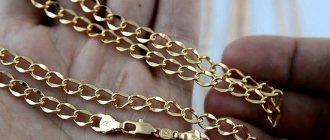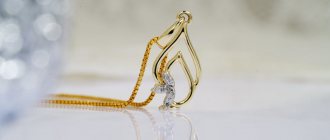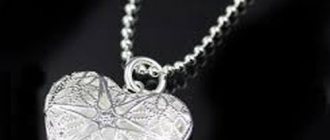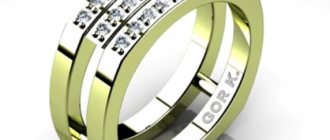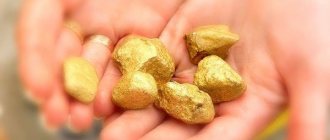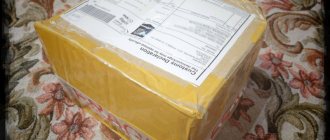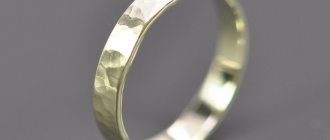May 18, 2021
How to distinguish gilded silver from gold is not an idle question, because modern jewelry making technologies have also made it possible to develop a market for counterfeits. Unscrupulous craftsmen surprise with tricks due to which the noble metal becomes less and less distinguishable from a cheap replica. However, there are a number of methods that allow you to quickly determine the authenticity of gold jewelry without laboratory examinations.
In this material you will learn how to check whether it is gold or gilding, as well as what are the different methods for making gold-plated products.
What is gilding
Gold plating is a thin layer of gold that can hide almost any material. Its thickness can be from 1 to 20-25 microns, and the object becomes practically indistinguishable from gold. The method is used not only in jewelry, but also in architecture, design and even cosmetology.
Brief history of appearance
The art of gilding luxury items first appeared several thousand years ago in Ancient Egypt. It was he who became the first country in which gold mining took on an industrial scale. Since all the mines belonged to the pharaoh, it is not surprising that household items of the ruling family were the first to be gilded.
There is an alternative version that claims that the practice of gold plating originated in China. However, a simple comparison of historical facts speaks in favor of Egypt. The gold-plated sarcophagi of the Egyptian pharaohs date back more than 5,000 years, while in Lao Tang (the province of China considered the birthplace of gilding), thin gold plates have only been produced for about 2 millennia.
The art of gilding, having passed through the Middle East and reached Ancient Rus', received a significant impetus for development and reached a completely new level. It was in Rus' that gold became not just a sign of status and luxury, but also a symbol of faith and divine light.
Expert opinion
Vsevolod Kozlovsky
6 years in jewelry making. Knows everything about samples and can identify a fake in 12 seconds
The popularity of gilding, so beloved by Russian people, led to the creation of an original school, the development of its own methods and secrets. Gilding masters took boys from a very early age to teach them all the subtleties of their profession. And only a few of them actually reached the heights of mastery.
The next step in the development of art is the merit of architects, primarily Bartolomeo Rastrelli. It was he who brought into fashion the Baroque style, which is characterized by gilding not only furniture, but also stucco.
Discovery of the galvanic method by B.S. Jacobi made gilding jewelry safer and easier in the 19th century. Electroplating has taken the technique of applying gold plating to a new level.
Double gilding
This type of gilding can be called a real art. The most sophisticated clients will be delighted with the work of our company’s craftsman, who used double gilding. The meaning of fine jewelry work is to apply painting to the product using noble metal. It is performed in 3 stages:
- The top layer of the object, on which double gold plating will be applied, is carefully cleaned, leveled and covered with polyment.
- The main gold plating is applied to the layer prepared in this way.
- After the first layer has dried, the artist uses it to create a drawing in gold of a different shade.
This delicate work is also within the capabilities of our company’s craftsmen. Any client will be delighted with the results obtained and will turn to us with a similar request more than once.
Where is it used?
Today, gold plating is used in the following areas:
- jewelry making;
- art (in sculpture; in painting, gilding is used not only on frames, but also directly on paintings);
- Interior design;
- automotive industry (for decorative purposes);
- dentistry;
- electronics (gold is an excellent conductor);
- cosmetology.
The last area of application is the most controversial. Most often, the use of gold in cosmetology is just a cunning marketing ploy. Nevertheless, in Japan they are working on the latest technique of gilding the face. It is believed that this metal enriches the skin with oxygen, preserves collagen and helps relieve irritation.
There is even a separate direction in alternative medicine - chrysotherapy, in which gold is used to treat inflammation. From a scientific point of view, such properties of the metal have not been proven, since a full-scale study of the effect of gold on the human body has never been carried out. But the placebo effect cannot be ignored.
Application methods
There are many known methods of gilding. The choice is determined primarily by the nature of the surface and the professionalism of the craftsman.
Fire or mercury
One of the very first methods that was used for gilding temple domes. Its essence is that a special mixture based on mercury was prepared, which was subsequently evaporated. Due to the danger to the health and life of the master, this technique is a thing of the past.
Oil based
Another name for the method is Mordan gilding, from the name of a special glue. The method is suitable for both interior and exterior work. Mordan can be purchased in specialized online stores.
Clay based
Clay-based gilding (polyment) is used only for wood and is not suitable for exterior decoration. In the old days, this was one of the most difficult and time-consuming methods, since the preparation of polyment required rare and very expensive ingredients at that time, including whale oil. The mixture was diluted using egg white. Now you can find ready-made mixtures on sale.
Water-synthetic
For this method of gilding, mixtures based on water are used. The advantage is that you can quickly prepare the surface. The gold-plated product is glossy and does not require final polishing.
Garlic
One of the oldest methods. Fresh garlic juice was squeezed onto the surface. After it dried, the surface was polished, moistened and gold leaf was applied. According to experts, this method gives the gilding a special shine.
Kinds
The most common type is still gilding. Also in recent years, gold leaf gilding has become popular among decorators, which is much more accessible and cheaper.
Gold leaf
Gold leaf is 960-carat metal, rolled out to a thin sheet. In Rus', gold leaf was traditionally used to cover the domes of churches. In Russia it is sold in the form of books of 60 sheets with an area of 10 cm2 each.
The thickness is not regulated, but the most popular sheets are 10 times thinner than a human hair. It is used to decorate objects of art and for interior design. For outdoor decoration (fountains, domes, sculptures) thicker sheets are used.
Potal
Potal is a replacement for the usual gold leaf. It appears as gold sheets or strips and is an alloy of copper and zinc or aluminum. There is a potal imitating gold, silver and bronze. A drawing can be applied to the sheets. You can find gold leaf on sale in the form of multi-colored crumbs.
What are their differences?
The main difference between gold and gold is that it does not contain precious metal. This naturally affects its price: gold leaf is much cheaper. Without a protective coating, it may fade over time.
What metals can be gilded
Jewelers quite often use gold plating for silver items. Bronze, copper, cast iron, brass, aluminum, galvanized iron and other well-known metals can also be coated with gold. Certain industries practice gilding of wooden, clay, plastic, and plaster objects. A gold layer can be added to ceramics and cardboard.
Gilding decoration
Difference between gold and gilding
The main difference is in the composition. Even a professional cannot always distinguish them by their appearance. Gold jewelry is durable, since the layer does not wear off, and is often much more expensive. Due to their short service life, gold-plated items are not worn every day and require more careful care.
With the development of technology, new methods of gilding have appeared. They allow you to achieve a thicker coating. Such bracelets and rings last much longer, but their price is higher than regular gold plated ones.
Markings.
Plated jewelry is usually marked with one of the following symbols: GP, RGP, GEP, HGP or HGE.
If you see one of these letter combinations after the carat number (for example, “14K GP”), then this is a sign that the item is gold plated.
A gold plated item may not be marked with a stamp indicating that the jewelry is gold plated, but if you see a marking indicating the standard silver purity value on the gold surface, then it is highly likely that the item has a silver base.
For example, o means 92.5% silver content, and if you see it on gold, it usually means that the item is actually made from a 92.5% silver alloy that has a gold plating.
How to spot a fake
According to statistics, 4 out of 10 gold jewelry is fake. Unfortunately, you can buy gilding for the price of full gold even in a jewelry store. There is only one method of checking that would allow you to avoid counterfeiting at the purchase stage - make a transaction in large, trusted jewelry stores and be very attentive to the product itself.
Signs that jewelry is fake:
- Uneven color. Gold plating can wear off in places even with careful storage and transportation. Moreover, the fakes use a very thin layer.
- Some “experts” on the Internet advise checking with a magnet. Gold should not be magnetic. However, given that many metals do not react to magnets, this method is practically useless.
- Very often, scammers remove the stamped lock from real gold jewelry and attach it to gold plated jewelry. Therefore, one way to identify a fake is to carefully examine the links next to the lock. Any defects in this area may indicate that this is a fake.
At home, if the product has already been purchased, it is much easier to check:
- Chemical method. You can purchase a special set of reagents for testing. This method is suitable for those who often buy gold and not always in reliable places.
- You can drop alcohol onto the surface: low-quality gold will darken.
- If in search of the truth you don’t mind spoiling the appearance of the jewelry, then you can scratch the surface. Small particles will fall off the gilding, leaving noticeable damage.
The most reliable way to check is always a consultation with a specialist. For a small fee, any pawn shop will conduct a series of tests and samples to ensure authenticity.
Restoration of gilding
Has the gilding lost over time or lost its former rich appearance under the influence of unfavorable atmospheric factors? No problem. It is worth turning to the craftsmen of 6 Micron LLC for help, and jewelry or gold-plated household items that have become unpresentable will return to their original shine and rich appearance in the shortest possible time. A huge number of products requiring restoration of gold plating, both modern and ancient, have passed through the hands of the employees of our production and research company, so they have extensive experience in this matter, allowing them to fully satisfy the needs of the most demanding client.
Characteristics of gold
Like all metals, gold has a number of characteristics: density, hardness, thermal and electrical conductivity, refractoriness, ductility, color.
Gold is practically chemically inactive, which determines its durability. It is plastic, so products can have complex shapes.
Sound
If gold is thrown onto a flat, hard surface or into a glass goblet, it sounds clear and clear. The method is not suitable for bracelets and chains, but a ring can be checked quite well.
Bite (strength test)
The higher the standard, the softer the gold. High strength does not indicate low quality, but indicates the addition of metals, as a result of which the product becomes wear-resistant.
Care, cleaning and storage of gold-plated items
In order for your jewelry to last as long as possible, you must follow a few simple rules for caring for gold plating.
| Wearing | Be sure to remove gold-plated jewelry before any contact with water (shower, swimming pool, washing dishes) or sports activities. Avoid contact with cosmetics. Don't forget that everyday wear shortens their service life. |
| Storage | Store only in a separate box or fabric bags so as not to damage the layer with other decorations. |
| Cleaning | Clean only with a soft cloth without using abrasives. If dark spots just appear, just wipe with ordinary vinegar and rinse in water. The shine will help return the egg white (after it you will also need to rinse in clean water). Once a year, items should be taken to a jeweler for professional cleaning. |
Despite the fact that sooner or later the coating wears off, it can always be renewed in a jeweler’s workshop.
Gold plating methods at home
With certain skills, compliance with safety precautions and the presence of a well-ventilated room, gilding can be done independently at home.
Preparation and use of gold chloride
Procedure:
- Prepare aqua regia.
- Dissolve any gold item in it.
- Carefully evaporate to a dry residue.
Attention: the process must be carried out very carefully, since acid fumes can cause serious harm to the respiratory tract, and there is also a high risk of chemical burns to the skin.
- Mix the resulting gold chloride with chalk and a solution of potassium cyanide to a mushy state.
- Using a brush, cover the product.
- After the surface has dried, it must be thoroughly washed and polished.
Application of zinc contact
If a thicker layer is needed, then zinc is used. It is also necessary to prepare gold chloride for it.
Procedure:
- Clean the item thoroughly and degrease it.
- Prepare the composition by mixing gold chloride with carbonic potassium, yellow blood and table salt in water.
- Heat.
- Place the item to be gilded in a container with a warm mixture.
- When the products are already in the solution, place a zinc stick in the container.
- Rinse, dry and polish.
If necessary, the product is covered with a protective layer.
Galvanic method
The galvanizing method is similar to galvanizing, but produces a more durable coating. By changing the composition of the solution, you will get different shades of gold. You will need a current rectifier and any glass container that can withstand high temperatures.
Procedure:
- Clean, degrease the product, sand it using paste and sandpaper.
- If the product is made of steel, zinc or tin, first coat it with copper.
- Prepare electrolytes from water, sodium phosphorus, gold chloride, potassium cyanide and sodium disulfide.
- Heat the resulting solution to 60 °C.
- Install the anode.
Electroplating takes from 12 to 16 hours. At the end of the process, the product is dried on sawdust and polished.
If gilding of a small surface is required, it is easier to purchase a special galvanic pencil.
Gilding on the Gulfarba
Gilding “on Gulfarba” allows you to get a matte finish. Gulfarba is a mixture of varnish, drying oil, and pinene. The surface is treated with Gulfarba, and the next day a layer of gold leaf is applied to it. Thanks to the solvent in the composition, the surface becomes matte.
